The Ultimate Guide to Ready Meal Sterilization Machines in 2024
Working Principle of Ready Meal Sterilization Machine
The working principle of a Ready Meal Sterilization Machine involves several stages to achieve thorough sterilization while maintaining the integrity of the packaged meals.
The process begins with pre-heating, where the packaged meals are subjected to controlled heat to raise their temperature gradually. This step prepares the meals for the sterilization process and helps in reducing the microbial load before the main sterilization phase.
Once the pre-heating stage is completed, the meals enter the sterilization chamber, where they are exposed to high temperatures and pressure. The combination of heat and pressure effectively kills harmful microorganisms present in the food, ensuring its safety for consumption. Depending on the type of Ready Meal Sterilization Machine, different methods such as steam, hot water, or dry heat may be employed for sterilization.
After sterilization, the meals undergo a cooling process to reduce their temperature rapidly. This step is crucial for preventing overcooking and maintaining the texture and quality of the food. Rapid cooling also helps in inhibiting the growth of any remaining microorganisms that might have survived the sterilization phase.
Once the meals are cooled, they are immediately packaged in a sterile environment to prevent any contamination post-sterilization. Packaging materials used are carefully selected to ensure they comply with food safety regulations and maintain the freshness of the meals during storage and transportation.
Throughout the entire sterilization process, strict quality control measures are implemented to monitor factors such as temperature, pressure, and sterilization time. Advanced sensors and monitoring systems are integrated intoReady Meal Sterilization Machine to ensure consistent and reliable sterilization results batch after batch.
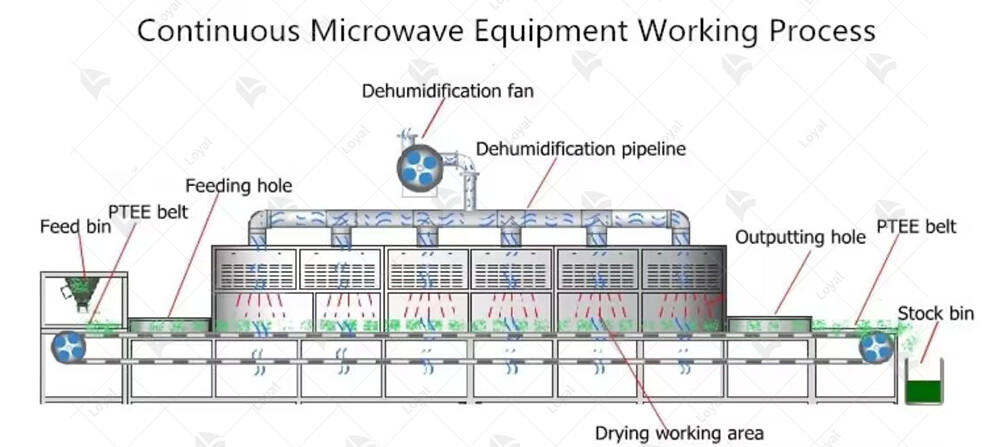
The Structure and Functionality of Ready Meal Sterilization Machines
The structure of Ready Meal Sterilization Machine typically consists of several key components. Firstly, there is the microwave chamber, which houses the food products during the sterilization process. This chamber is designed to allow for even distribution of microwave energy, ensuring thorough and uniform sterilization.
Within the microwave chamber, there are specialized trays or conveyor belts that hold the individual meal packages. These trays are made from materials that are compatible with microwave radiation and are designed to withstand the heat generated during the sterilization process.
At the heart of the machine is the microwave generator, which produces the electromagnetic waves used for sterilization. This generator must be precisely calibrated to ensure the correct frequency and power output for effective pathogen elimination without compromising the quality of the food.
Additionally, ready meal sterilization machines are equipped with sophisticated control systems that regulate various parameters such as temperature, humidity, and exposure time. These controls allow operators to customize the sterilization process according to the specific requirements of different food products, ensuring optimal results every time.
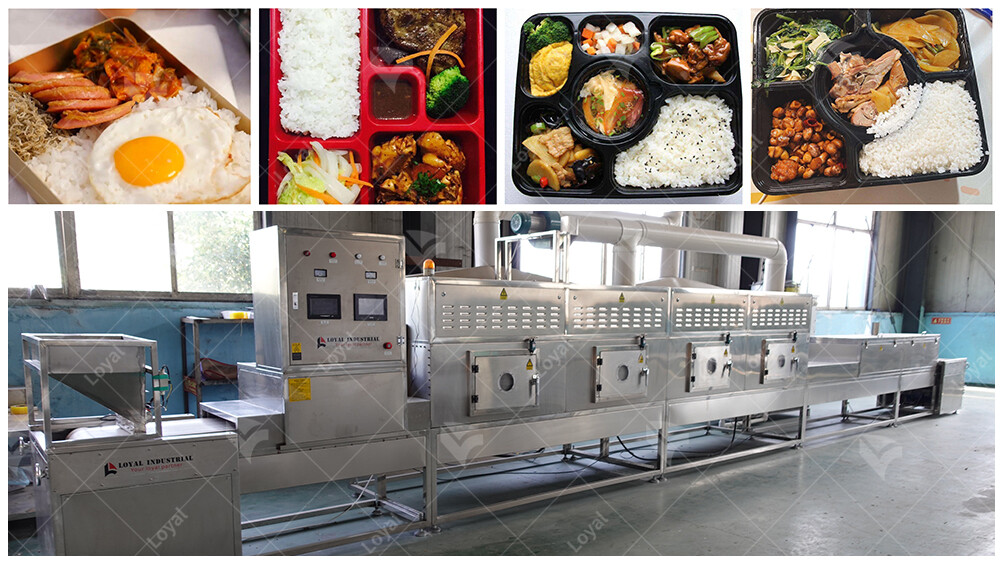
What Is Ready Meal Sterilization Machine?
A Ready Meal Sterilization Machine is a sophisticated piece of equipment designed specifically for the food processing industry. Its primary purpose is to ensure the safety and quality of pre-packaged meals by eliminating harmful microorganisms that may be present. These machines play a crucial role in preserving the integrity of ready-to-eat meals, making them safe for consumption over an extended period.
At its core, a Ready Meal Sterilization Machine utilizes a combination of heat, pressure, and sometimes chemicals to achieve sterilization. The process typically involves loading pre-packaged meals into a chamber, which is then sealed shut. The machine then raises the temperature and pressure to levels necessary for sterilization, effectively neutralizing any pathogens present. This meticulous process ensures that the meals remain free from harmful bacteria and viruses.
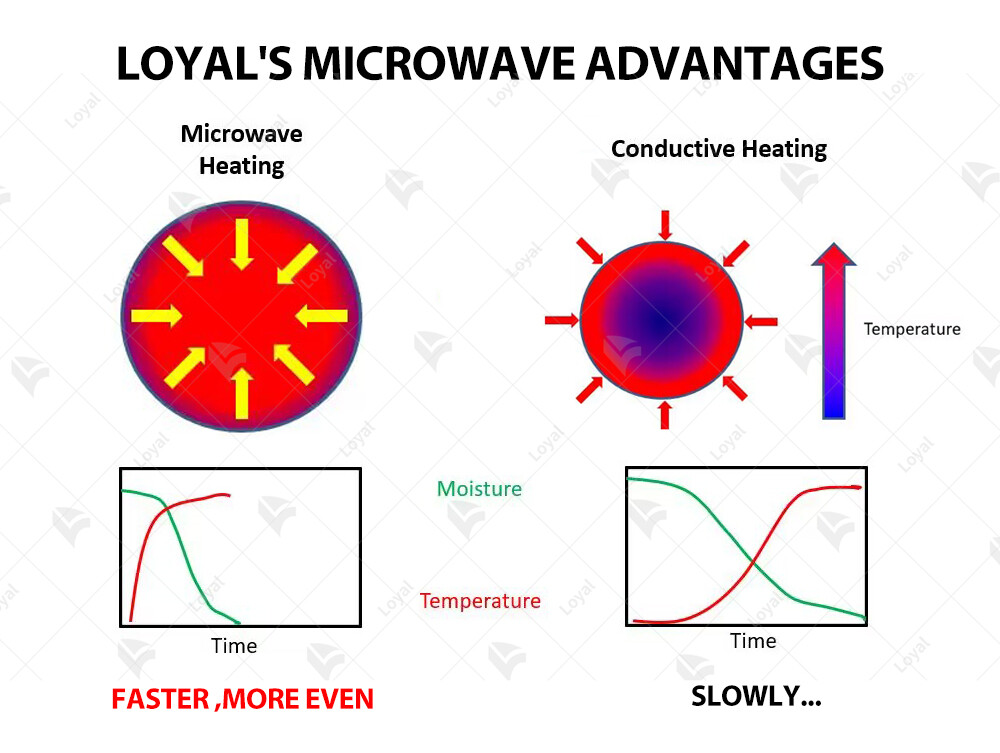
Advantages Of Using A Ready Meal Sterilization Machine
One of the paramount advantages of employing a Ready Meal Sterilization Machine is the assurance of food safety. These machines utilize state-of-the-art sterilization techniques, such as heat treatment and irradiation, to eliminate harmful pathogens like bacteria and viruses. By effectively sterilizing the ready meals, the risk of foodborne illnesses is significantly reduced, ensuring consumer health and satisfaction.
Another key benefit is the extension of the shelf life of ready meals. Through precise control of sterilization parameters, including temperature and exposure time, these machines inhibit microbial growth and enzymatic activities that lead to food spoilage. As a result, manufacturers can distribute their products over longer distances and store them for extended periods without compromising quality, thereby reducing food wastage and enhancing profitability.
Ready Meal Sterilization Machine
are designed to maintain the nutritional integrity of food while eliminating harmful microorganisms. Unlike traditional preservation methods that may degrade vitamins and nutrients, such as canning or freezing, sterilization ensures minimal nutrient loss. This preservation of nutritional quality not only meets consumer preferences for healthy food choices but also aligns with industry trends promoting clean-label products.
Integrating a Ready Meal Sterilization Machine into the production process can lead to significant cost savings for food manufacturers. By streamlining operations and reducing the need for preservatives and additives, these machines optimize efficiency and minimize production expenses. Additionally, the prolonged shelf life of sterilized ready meals translates to reduced inventory turnover and less frequent restocking, further lowering overhead costs.
In an increasingly stringent regulatory environment, compliance with food safety standards is non-negotiable for manufacturers. Ready Meal Sterilization Machine facilitate adherence to regulatory requirements by providing a validated sterilization process that meets industry standards and guidelines. By ensuring consistency and traceability in the sterilization process, these machines enable manufacturers to demonstrate due diligence and uphold their commitment to consumer safety.
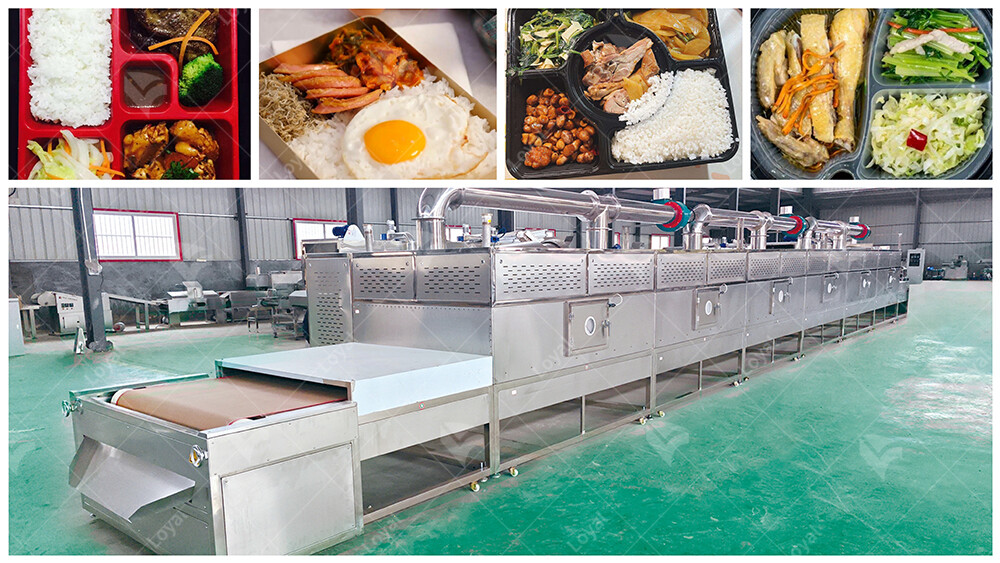
List of common accessories for microwave sterilizers
List of common accessories for microwave sterilizers:
1. Sterilization Trays: These trays are designed to hold ready meals securely during the sterilization process, ensuring even exposure to microwave energy.
2. Temperature Probes: Temperature probes are used to monitor and regulate the internal temperature of the sterilizer, ensuring optimal sterilization conditions.
3. Sealing Materials: Sealing materials such as film and lids are essential for securely sealing pre-packaged meals before they undergo the sterilization process.
4. Cleaning Tools: Brushes, sponges, and other cleaning tools are necessary for maintaining the cleanliness and hygiene of the sterilization equipment.
5. Safety Gear: Safety gear including gloves, goggles, and aprons protects operators from potential hazards associated with operating sterilization machines.
Incorporating these accessories into your microwave sterilization process helps to streamline operations and ensure the safety and quality of ready-to-eat meals.
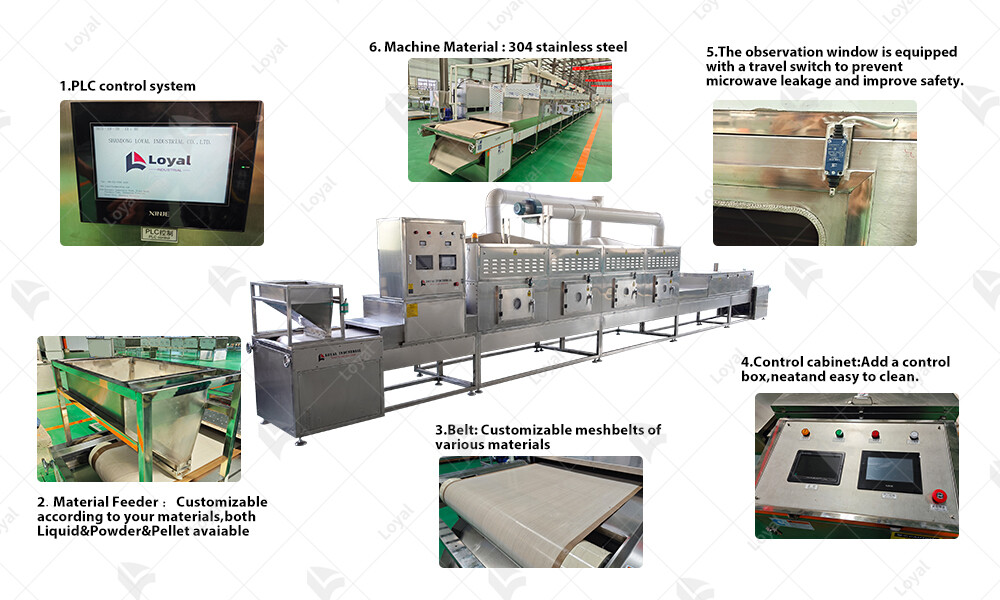
Application of Ready Meal Sterilization Machine
Ready Meal Sterilization Machine are ideal for large-scale food production facilities that handle a high volume of ready-to-eat meals. These machines offer rapid processing capabilities, allowing manufacturers to meet demand efficiently without compromising quality or safety. Whether it's pre-packaged meals for retail or bulk orders for institutional catering, the scalability of sterilization machines makes them indispensable for industrial applications.
With the growing diversity of dietary preferences and restrictions, food manufacturers face the challenge of catering to a broad range of consumer needs.microwave sterilization machine enable flexibility in product development by accommodating various food types and formulations. Whether it's conventional, organic, gluten-free, or plant-based meals, these machines ensure uniform sterilization across different recipes, enabling manufacturers to appeal to diverse consumer segments.
In an interconnected global market, ready meal manufacturers must navigate logistical challenges associated with international distribution.Ready Meal Sterilization Machine play a crucial role in facilitating global trade by ensuring the safety and quality of products during transit and storage. By sterilizing ready meals effectively, these machines mitigate the risk of contamination and spoilage, thereby enabling manufacturers to expand their reach and tap into new markets with confidence.
The rise of on-demand meal services, driven by changing consumer lifestyles and preferences, necessitates innovative solutions for food preparation and delivery. Ready Meal Sterilization Machines enable the efficient production of pre-packaged meals that meet the demands of on-the-go consumers. Whether it's microwaveable convenience meals or pre-cooked entrees for home delivery, these machines ensure the safety and convenience of ready-to-eat options in the burgeoning food delivery market.
In the foodservice and hospitality sector, where speed and consistency are paramount, Ready meal pasteurization microwave equipmentmachine offer a competitive advantage. These machines enable central kitchen operations to prepare large quantities of ready meals in advance, which can be quickly reheated and served to patrons without compromising quality. From airline catering to hotel room service, the versatility of sterilization machines meets the demands of diverse foodservice establishments, enhancing operational efficiency and customer satisfaction.
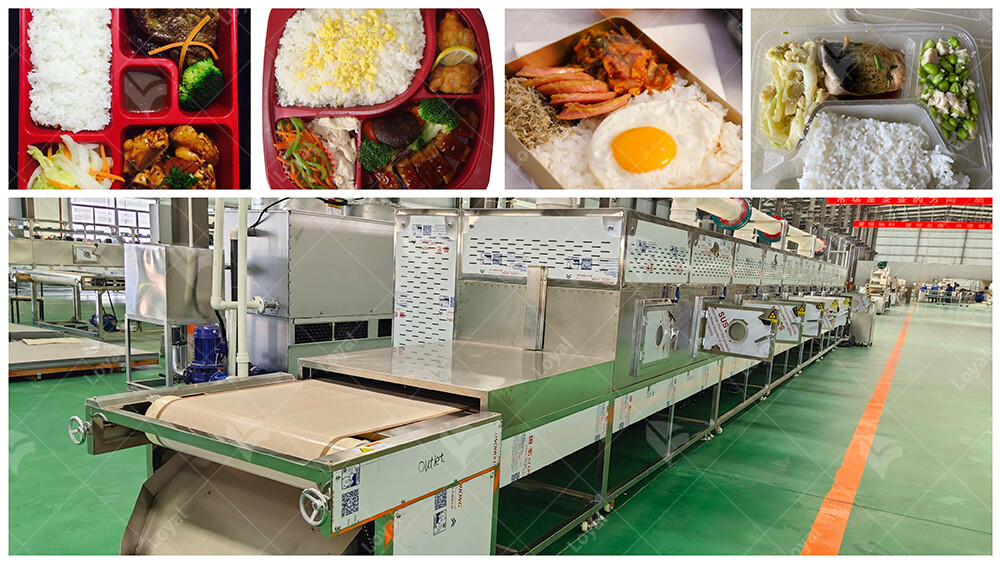
Using microwave technology to improve the production efficiency of ready-to-eat food drying?
The even distribution of heat provided by microwave sterilization machines not only accelerates the drying process but also contributes to a superior end product. With traditional methods, there's a risk of over-drying the exterior while the interior remains moist, leading to uneven texture and compromised taste. Microwave technology mitigates this issue by uniformly heating the Ready Meal from within, ensuring that moisture is uniformly evaporated. As a result, manufacturers can consistently deliver Ready Meals with optimal texture, flavor, and nutritional integrity, meeting consumer expectations for quality and satisfaction.
In addition to enhancing drying efficiency, microwave sterilization machines offer the added benefit of reducing energy consumption. Unlike conventional sterilization methods that require prolonged heating periods and substantial energy inputs, microwave technology operates on a more efficient and targeted basis. By directly applying energy to the product, microwave sterilization minimizes heat loss and unnecessary energy expenditure, ultimately translating into cost savings for manufacturers. This environmentally conscious approach aligns with industry trends towards sustainability and resource conservation, making microwave sterilization an attractive option for Ready Meal production facilities looking to minimize their carbon footprint.
The efficiency gains achieved through microwave sterilization extend beyond the drying stage, impacting the overall production process. With faster drying times and reduced energy requirements, manufacturers can streamline their operations and optimize production schedules. Microwave sterilization machines enable greater flexibility in production planning, allowing for shorter cycle times and increased throughput. This agility is particularly advantageous in meeting fluctuating consumer demand and adapting to market trends promptly. By integrating microwave technology into their sterilization processes, manufacturers can achieve greater efficiency and responsiveness, positioning themselves competitively in the dynamic Ready Meal market landscape.

Choosing the Right Machinery: Factors to Consider
When selecting a Ready Meal Sterilization Machine for your production facility, several factors come into play. Firstly, consider the capacity and throughput requirements of your operation. Ensure that the machine can handle your production volume efficiently without causing bottlenecks. Additionally, evaluate the sterilization effectiveness of the machine, ensuring that it meets regulatory standards for food safety. Furthermore, assess the versatility of the machine, as it should be able to accommodate various types of ready meals and packaging formats.
Technical Parameters Of Continuous Microwave Dryer Industrial Microwave Drying Machine | |||||
Model | Size L*W*H(Can be customized according to the customer's requirements) | Output power | Dewaterability | Sterilization capacity | Baking and Roasting capacity (Depends on different raw material) |
LY-10KW | 5000mm*825mm*1750mm | ≥10KW | 10KG/Hour | 100KG/Hour | 30-50KG/Hour |
LY-20KW | 8000mm*825mm*1750mm | ≥20KW | 20KG/Hour | 200KG/Hour | 60-100KG/Hour |
LY-30KW | 8500mm*1160mm*1750mm | ≥30KW | 30KG/Hour | 300KG/Hour | 90-150 KG/Hour |
LY-40KW | 10000mm*1160mm*1750mm | ≥40KW | 40KG/Hour | 40KG/Hour | 120-200KG/Hour |
LY-50KW | 12500mm*1160mm*1750mm | ≥50KW | 50KG/Hour | 500KG/Hour | 150-250KG/Hour |
LY-60KW | 13500mm*1450mm*1750mm | ≥60KW | 60KG/Hour | 600KG/Hour | 180-300KG/Hour |
LY-70KW | 13500mm*1500mm*1750mm | ≥70KW | 70KG/Hour | 700KG/Hour | 210-350KG/Hour |
LY-80KW | 13500mm*1650mm*1750mm | ≥80KW | 80KG/Hour | 800KG/Hour | 240-400KG/Hour |
LY-100KW | 16800mm*1650mm*1750mm | ≥100KW | 100KG/Hour | 1000KG/Hour | 300-500KG/Hour |
LY-150KW | 22400mm*1850mm*1750mm | ≥150KW | 150KG/Hour | 1500KG/Hour | 450-750KG/Hour |
LY-200KW | 27000mm*1850mm*1750mm | ≥250KW | 250KG/Hour | 2500KG/Hour | 750-1250/Hour |
LY-300KW | 32000mm*1850mm*1750mm | ≥300KW | 300KG/Hour | 3000KG/Hour | 900-1500KG/Hour |
Types of Ready Meal Sterilization Machines for Ready Meal Drying
Microwave Sterilization Machines: Microwave technology offers rapid and uniform heating, making it ideal for drying ready meals efficiently. These machines utilize electromagnetic waves to penetrate the food, heating it from the inside out. The Ready Meal Sterilization Machine employs microwave technology, ensuring thorough sterilization while preserving the nutritional content and taste of the food.
Batch Sterilization Machines: Batch sterilization machines are suitable for small to medium-scale production. They operate by loading a batch of ready meals into the chamber, where they undergo the sterilization process. While effective, batch sterilization machines may have longer processing times compared to continuous systems.
Continuous Sterilization Machines: Continuous sterilization machines are designed for large-scale production, offering high throughput and efficiency. These machines feature a continuous conveyor belt system, allowing for a continuous flow of ready meals through the sterilization process. With the Ready Meal Sterilization Machine, manufacturers can achieve significant improvements in production efficiency and output.
Vacuum Sterilization Machines: Vacuum sterilization machines create a low-pressure environment, which helps in reducing the sterilization time and preserving the quality of ready meals. By removing air from the chamber, vacuum sterilization machines enhance the penetration of heat, ensuring effective sterilization. The Ready Meal Sterilization Machine utilizes vacuum technology, optimizing the drying process and minimizing production time.
Hybrid Sterilization Machines: Hybrid sterilization machines combine multiple sterilization technologies, such as microwave and infrared, to achieve superior results. These machines offer flexibility and versatility, allowing manufacturers to tailor the sterilization process according to specific requirements. With the Ready Meal Sterilization Machine, companies can optimize drying production efficiency while maintaining product quality and safety.
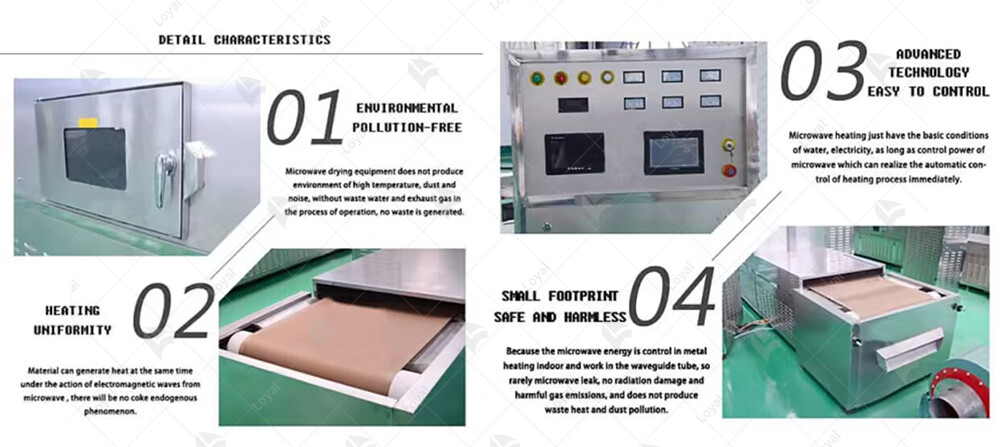
Key Features To Consider In Ready Meal Sterilization Machine
The sterilization method employed by the machine is paramount. High-pressure processing (HPP), steam sterilization, and microwave sterilization are among the most common techniques utilized. Each method has its advantages and limitations. HPP, for instance, preserves the sensory attributes of the food product, while steam sterilization ensures thorough pathogen elimination. Microwave sterilization, on the other hand, offers rapid processing times. Choosing the appropriate sterilization methodology depends on factors such as the nature of the food product and desired shelf life.
Efficiency and precision are crucial in the sterilization process. Modernmicrowave sterilization machine are equipped with advanced automation and control systems to streamline operations and minimize human error. These systems facilitate precise temperature and pressure control, ensuring consistent sterilization results batch after batch. Additionally, remote monitoring capabilities allow for real-time oversight, enhancing operational transparency and efficiency.
The compatibility of materials with the sterilization process is vital to prevent contamination and ensure product safety. Stainless steel construction is preferred for its durability, corrosion resistance, and ease of cleaning. Additionally, food-grade seals and gaskets must be used to maintain integrity during sterilization cycles. Compatibility with various packaging materials, including plastics, aluminum, and glass, is also essential to accommodate diverse product offerings.
The throughput capacity of the sterilization machine determines its productivity and scalability. Manufacturers must assess their production requirements and select a machine capable of handling the anticipated volume efficiently. Factors such as cycle time, loading configuration, and conveyor speed influence throughput capacity. Investing in a machine with sufficient capacity to meet current demands while allowing for future expansion is prudent for long-term viability.
Adherence to regulatory standards and certifications is non-negotiable in the food industry.Ready Meal Sterilization Machine must comply with stringent regulations set forth by authorities such as the Food and Drug Administration (FDA) and the European Food Safety Authority (EFSA). Certification bodies like ISO and HACCP provide additional reassurance of quality and safety compliance. Choosing a machine from a reputable manufacturer with a track record of regulatory compliance is essential to mitigate risk and uphold consumer trust.

Understanding The Role Of Ready Meal Sterilization Machine in Ready Meal
Ready Meal Sterilization Machine play a pivotal role in ensuring the safety, quality, and shelf stability of ready-to-eat meals. By effectively eliminating harmful microorganisms while preserving nutritional content and sensory attributes, these machines enable manufacturers to deliver safe and convenient meal options to consumers.
In the production of ready meals, microbial contamination poses a significant risk to food safety. Pathogenic bacteria, such as Salmonella and Listeria, can proliferate in improperly sterilized environments, leading to foodborne illnesses and product recalls. Ready meal sterilization machines employ various sterilization methodologies to eradicate these pathogens and extend the shelf life of packaged meals.
Ready Meal Sterilization Machine contribute to operational efficiency and cost effectiveness in food manufacturing facilities. By automating the sterilization process and optimizing throughput capacity, these machines minimize production downtime and labor costs while maximizing output. This increased efficiency translates to higher profitability and competitiveness in the market.
Rady meal sterilization machines are indispensable assets in the food industry, ensuring the safety, quality, and marketability of ready-to-eat meals. By considering key features such as sterilization methodology, automation systems, material compatibility, throughput capacity, and regulatory compliance, manufacturers can make informed decisions and invest in equipment that meets their production needs while upholding the highest standards of food safety and quality.

Expertise Of Engineers In Microwave Ready Meal Drying
Microwave technology has revolutionized the food industry, particularly in the realm of ready meal sterilization. Engineers specializing in microwave ready meal drying possess a profound understanding of the intricate mechanisms involved in this process. They utilize their expertise to design and optimize drying systems that effectively remove moisture from ready meals while preserving their quality and flavor.
These engineers employ advanced computational modeling techniques to simulate and analyze the behavior of microwave energy within the food product. By carefully adjusting parameters such as power levels, frequency, and exposure time, they can achieve precise control over the drying process, ensuring uniform results across different batches of ready meals.
Furthermore, their expertise extends to the development of innovative packaging materials that are compatible with microwave heating, facilitating efficient heat transfer and preventing overheating or undercooking. Through continuous research and experimentation, engineers continually refine their techniques to enhance the efficiency and effectiveness of microwave ready meal drying systems, thereby meeting the ever-evolving demands of the food industry.

Importance Of Quality Control In Ready Meal Sterilization Machine
Ensuring the quality and safety of ready meal sterilization machines is paramount in the food processing industry. These machines are tasked with eliminating harmful bacteria and pathogens from ready meals, thereby preventing foodborne illnesses and ensuring consumer health and satisfaction. Quality control measures are indispensable to uphold the integrity and reliability of these essential devices.
The first aspect of quality control in ready meal sterilization machines involves meticulous testing and validation of their sterilization efficacy. Engineers employ rigorous protocols to assess the machine's ability to achieve the necessary temperature and pressure conditions for effective sterilization. Advanced sensors and monitoring systems are utilized to track key parameters in real-time, enabling prompt detection of any deviations from the desired operating conditions.
In addition to technical performance, quality control also encompasses the inspection of materials and components used in the construction of sterilization machines. High-quality stainless steel, corrosion-resistant alloys, and food-grade seals are essential to ensure hygiene and durability. Strict adherence to regulatory standards and industry best practices is imperative to mitigate risks and maintain compliance with food safety regulations.
Regular maintenance and calibration are essential aspects of quality control, ensuring that sterilization machines operate optimally throughout their lifespan. Preventive maintenance schedules are established to identify and address any potential issues before they escalate into major problems. Calibration procedures verify the accuracy of temperature, pressure, and timing mechanisms, guaranteeing consistent and reliable sterilization performance.
By prioritizing quality control measures, manufacturers can instill confidence in theirmicrowave sterilization machine, reassuring consumers of their safety and reliability. This commitment to excellence not only safeguards public health but also enhances the reputation and competitiveness of food processing companies in the global market.
Latest Innovations And Trends in Industrial Microwave Ready Meal Drying
Industrial microwave technology has emerged as a game-changer in the realm of ready meal drying. Unlike traditional drying methods, such as hot air drying, microwave drying offers several advantages, including faster processing times and better preservation of food quality. Ready Meal Sterilization Machine integrated with microwave technology has seen significant enhancements, enabling precise control over the drying process while maintaining the nutritional integrity of ready meals.
One prominent trend in industrial microwave ready meal drying is the utilization of advanced sensors and automation systems. These technologies allow for real-time monitoring of the drying process, ensuring optimal moisture removal while preventing over-drying or thermal degradation of the food products.Ready Meal Sterilization Machine equipped with state-of-the-art sensors can adjust drying parameters dynamically, resulting in consistently high-quality output.
Another notable innovation is the incorporation of energy-efficient designs inReady meal pasteurization microwave equipmentmachine. Manufacturers are increasingly focused on reducing energy consumption and environmental impact without compromising performance. Modern sterilization machines utilize innovative heating mechanisms and insulation materials to minimize heat loss and maximize energy transfer efficiency during the drying process.
There's a growing emphasis on the integration of artificial intelligence (AI) and machine learning algorithms in Ready Meal Sterilization Machines. These intelligent systems can analyze data from various sensors to optimize sterilization parameters adaptively. By learning from past drying cycles and product characteristics, AI-powered sterilization machines can continually refine their performance, leading to higher productivity and improved product quality.
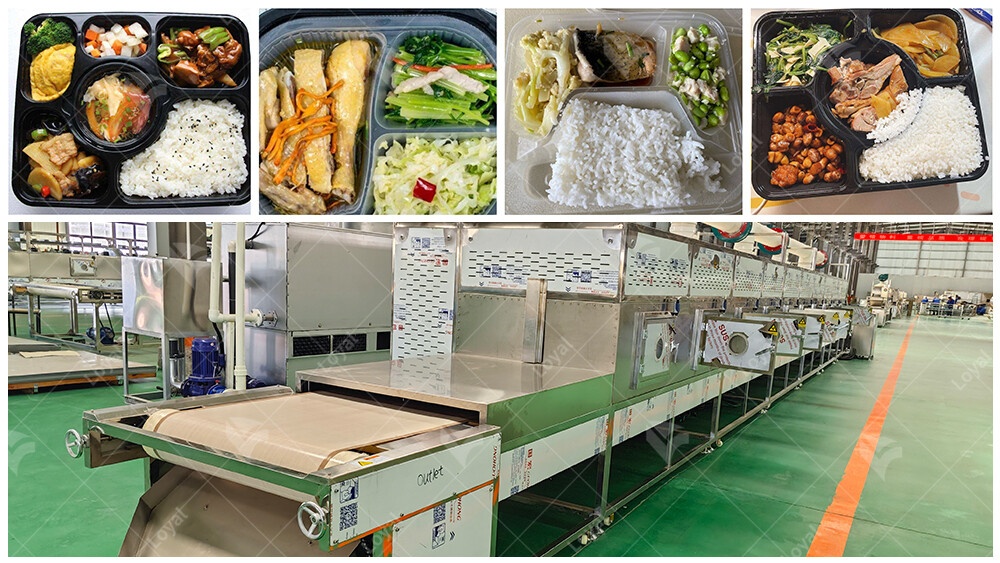
Advances in Ready Meal Sterilization Machine
The sterilization phase is a critical step in the production of ready meals, ensuring the elimination of harmful pathogens while extending shelf life. In recent years, significant advances have been made in Ready Meal Sterilization Machines, enhancing both their effectiveness and efficiency.
One notable innovation is the development of novel sterilization techniques that utilize a combination of heat, pressure, and other non-thermal methods. These techniques, such as high-pressure processing (HPP) and pulsed electric field (PEF) technology, offer advantages over traditional thermal sterilization methods in terms of preserving food quality and nutritional content. Ready Meal Sterilization Machines incorporating these techniques have gained popularity among food processors seeking alternatives to conventional pasteurization methods.
There's a growing focus on ensuring the sustainability of sterilization processes in response to environmental concerns. Manufacturers ofReady Meal Sterilization Machine are implementing eco-friendly solutions, such as water-saving systems, renewable energy sources, and recyclable materials, to minimize the carbon footprint of food processing operations. By adopting sustainable practices, companies can reduce resource consumption and waste generation while maintaining high standards of food safety and hygiene.

YouTube As a Knowledge Source for Industrial Microwave Ready Meal Drying
YouTube has indeed become an indispensable resource for food industry professionals, offering a wealth of information on various aspects of food production, including industrial microwave ready meal drying. The platform hosts a diverse range of content creators, from seasoned professionals to equipment manufacturers, who share their expertise through informative videos.
Through YouTube, professionals can gain valuable insights into the intricacies of microwave drying techniques specific to ready meals. These videos often delve into the science behind microwave heating, discussing factors such as frequency, power level, and moisture content that impact the drying process. By understanding these principles, manufacturers can fine-tune their drying parameters to achieve optimal results.
YouTube tutorials offer step-by-step guidance on operating and maintaining industrial microwave drying equipment. From setting up the machine to troubleshooting common issues, these videos provide practical knowledge that empowers manufacturers to utilize their equipment efficiently. Additionally, experts often share tips for preventive maintenance to prolong the lifespan of the machinery and ensure consistent performance.
YouTube fosters a sense of community among food industry professionals, encouraging collaboration and knowledge sharing. Viewers can engage with content creators through comments, asking questions and sharing their own experiences. This interactive dialogue facilitates the exchange of ideas and insights, enriching the collective knowledge base of the industry and driving continuous improvement.

References for Ready Meal Sterilization Research
When conducting research on Ready Meal Sterilization Machines, it's essential to consult authoritative sources to ensure accuracy and reliability. Here are five reputable foreign websites that provide valuable information on ready meal sterilization:
1. Food Safety Magazine (www.foodsafetymagazine.com)
2. Institute of Food Technologists (www.ift.org)
3. Food and Drug Administration (www.fda.gov)
4. European Food Safety Authority (www.efsa.europa.eu)
5. Food Standards Australia New Zealand (www.foodstandards.gov.au)
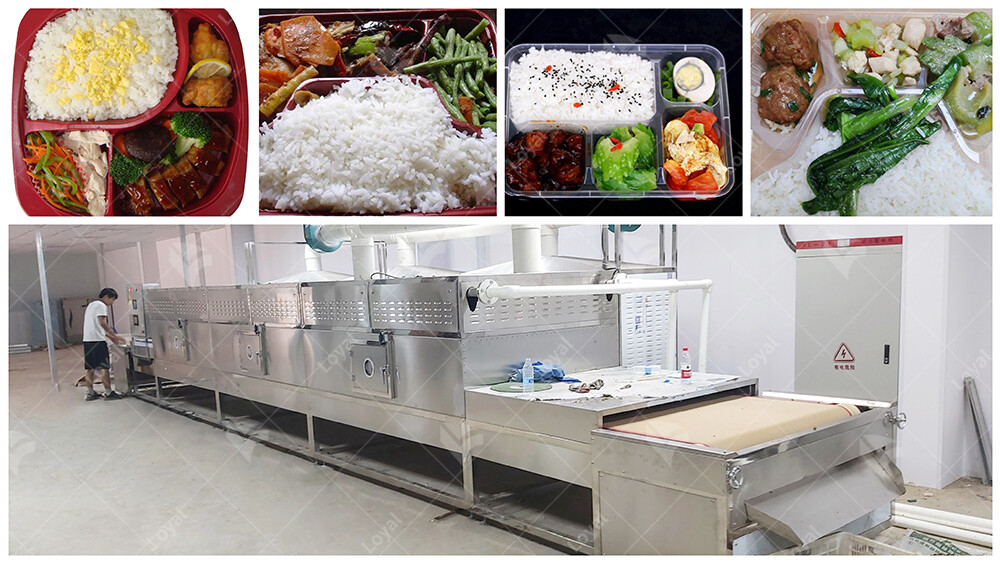
Frequently Asked Questions (FAQs)
1. What is a Ready Meal Sterilization Machine?
A Ready Meal Sterilization Machine is a piece of equipment used in the food industry to sterilize ready-to-eat meals. It employs advanced technologies such as industrial microwave heating to eliminate harmful microorganisms while preserving the taste and nutritional quality of the food.
2. How does a Ready Meal Sterilization Machine work?
microwave sterilization machine utilize a combination of heat and pressure to achieve rapid and thorough sterilization of food products. Industrial microwave heating is a common method employed, which effectively kills bacteria, viruses, and other pathogens present in the food, ensuring its safety for consumption.
3. What are the benefits of using Ready Meal Sterilization Machines?
There are several benefits to utilizing Ready Meal Sterilization Machines. Firstly, they help to extend the shelf life of ready meals by eliminating harmful microorganisms, thereby reducing the risk of foodborne illnesses. Additionally, these machines preserve the taste, texture, and nutritional content of the food, ensuring a high-quality product for consumers.
4. Is industrial microwave drying suitable for all types of ready meals?
Industrial microwave drying is a versatile technology that can be used for a wide range of ready meals, including soups, pasta dishes, and pre-cooked meats. However, the suitability of this method depends on factors such as the composition of the food, its moisture content, and desired texture. Manufacturers may need to optimize drying parameters for different products to achieve the best results.
5. Where can I find more information on Ready Meal Sterilization Machines?
For further information on Ready Meal Sterilization Machines, you can consult reputable sources such as industry publications, research journals, and websites of food safety organizations. Additionally, attending trade shows and conferences related to food processing and packaging may provide valuable insights into the latest advancements in sterilization technology.

 Telephone :+86-531-55583139
Telephone :+86-531-55583139 WhatsApp :+86 13256674591
WhatsApp :+86 13256674591 Email :
Email :










